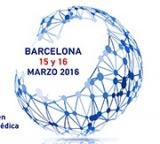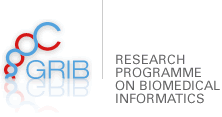
7/03/2016
The 2nd eTOX Hackathon starts today at PRBB
eTOX Hackathon will be celebrated from the 7th till 10th of March at the Barcelona Biomedical Research Park (PRBB). The objective of this event is to gather multidisciplinary teams from academic, SME and EFPIA partners to work on a number of specific cases that require close, hands-on collaboration between computational experts and toxicologists. The final goal of this exercise will be to mine the data collected in the project as well as other public sources in order to derive new in silico models for the prediction of the toxicity of drug candidates. The attendance confirmed to this event includes representatives of large pharmaceutical companies like Sanofi-Aventis, Bayer, Novartis and Roche, academia & research organisations such as FIMIM, Fraunhofer, CNIO and UPV, and SMEs Lead Molecular Design, Lhasa Ltd and Molecular Networks.
The eTOX project aims to develop a drug safety database from the pharmaceutical industry legacy toxicology reports and public toxicology data, innovative in silico strategies and novel software tools to better predict the toxicological profiles of small molecules in early stages of the drug development pipeline. The eTOX project is funded by the Innovative Medicines Initiative Joint Undertaking (IMI-JU), a unique partnership between the European Community and the European Federation of Pharmaceutical Industries and Associations (EFPIA) and coordinated by the GRIB (IMIM-UPF).

9/3/2016
Taller de Bioinformàtica del GRIB al Saló de l’Ensenyament
Aquesta serà la 27ª edició del Saló de l’Ensenyament que organitza Fira de Barcelona
El proper dijous 10 de març de 16 a 18 hores, en el marc de l'Espai Ciència del Salo de l'Ensenyament, el GRIB (IMIM-UPF) realitzarà un taller de Bioinformàtica adreçat als alumnes d'entre 16 i 18 anys que visiten el Saló de l'Ensenyament. L'activitat, liderada per Will Blevins, investigador del Grup de Recerca en Genòmica Evolutiva, té per objectiu despertar la curiositat sobre aquest camp de la ciència i explicar als visitants algunes de les interessants aplicacions que té la bioinformàtica.
L'activitat porta per títol "Saps per què serveix la bioinformàtica?" i es realitzarà a l'estand que CERCA ha posat a disposició dels seus centres adscrits. Estarà dividida en 4 tallers de 15 minuts cadascun que mostraran els diferents camps de la bioinformàtica amb senzills exemples i activitats:

4/2/2016
Núria López-Bigas guanya un ajut ERC Consolidator del Consell Europeu de Recerca
Núria López-Bigas es investigadora ICREA i cap del grup de recerca en Genòmica Biomèdica del GRIB (IMIM-UPF) que centra la seva recerca en l'estudi del càncer des d'una perspectiva genètica.
Les alteracions genètiques són, en darrer terme, les responsables de transformar una cèl·lula normal en una tumoral, i entendre la seva importància permet millorar el coneixement de la biologia de la malaltia i desenvolupar-ne millors tractaments. La majoria d'aquests estudis es centren en els canvis que s'observen a nivell de les regions codificants de l'ADN, és a dir, aquelles que contenen la informació per produir les proteïnes de la cèl·lula. Tanmateix, la resta del genoma, anomenat genoma no codificant, participa en la regulació d'aquest procés i les seves alteracions poden ser igualment rellevants.
El projecte a desenvolupar, de 5 anys de duració, té com objectiu caracteritzar el paper de les mutacions en regions no codificants en els tumors més prevalents en la població i comptarà amb la col·laboració del Consorci Internacional del Genoma del Càncer.

25/02/2016
Conferencia Anual de las Plataformas Tecnológicas de Investigación Biomédica
La IX Conferencia Anual de las Plataformas Tecnológicas de Investigación Biomédica: Medicamentos Innovadores, Nanomedicina, Tecnología Sanitaria y Mercados Biotecnológicos se celebrará los próximos días 15 y 16 de marzo en Barcelona. En la misma se persigue dar respuesta a nuevos retos en la investigación biomédica. Algunos, llegan de la mano de un nuevo marco normativo como el Real Decreto 1090/2015 de Ensayos Clínicos, que supone un cambio significativo en el país y permitirá una adaptación rápida y competitiva a las nuevas exigencias, cuando entre en vigor el nuevo Reglamento Europeo sobre la materia. Además, se tratarán de resolver otros retos, como la reutilización de datos para la investigación biomédica, salvaguardando las cuestiones éticas y legales, al mismo tiempo que se permite el avance científico. También se abordará la cuestión de la financiación nacional e internacional en la cooperación Farma-Biotech. Todos los asuntos se tratan desde una perspectiva nacional e internacional de colaboración público-privada.
Inscripciones hasta el 10 de marzo en www.medicamentos-innovadores.org

25/02/2016
Thesis defence of Noelia Ferruz: "Understanding ligand-receptor recognition by means of high-throughput molecular dynamics. A perspective for drug discovery"
Next Friday, 4th of March, Noelia Ferruz, member of the Computational Biophysics Group of GRIB (IMIM-UPF) will defense her thesis: "Understanding ligand-receptor recognition by means of high-throughput molecular dynamics. A perspective for drug discovery" at 12.00 h. at the Josep Marull room placed on the ground floor of Doctor Aiguader, 80 (Campus Mar Building). You are all invited to this event.

01/02/2016
Thesis defence of Nikita Remez on February the 8th at 11:00: " Drug design at biological systems level"
Next monday, 8th of February at 11.00, Nikita Remez, member of the Systems Pharmacology group of GRIB will defense his thesis "Drug design at biological systems level" at Josep Marull room placed on the ground floor of Doctor Aiguader, 80 (Campus Mar Building). You are all invited to this event.

12/01/2016
New genes formed continuously allowing acquisition of novel functions during evolution
Why are there genes that can only be detected in humans or chimpanzees and that cannot be found in any other species? How are new genes formed during evolution?
Barcelona, 11 January, 2016 - Research just published in the journal Plos Genetics has found that gaining new genes during evolution is a much more frequent event than previously thought. It has been seen that there are hundreds of genes that might be unique to humans, and something similar occurs in chimpanzees. Some of these genes will be useful for the organism in question and the rest will disappear in time. The work was led by Mar Albà, an ICREA researcher of the Evolutionary genomics group of GRIB (IMIM-UPF) and Jorge Ruiz-Orera, from the same group, together with researchers from Pompeu Fabra University (UPF) and the Centre for Genomic Regulation (CRG).
For some time it was thought that all new genes originated from other genes, for example, from duplications of already existing genes. But recently it has been seen that some, the so-called de novo genes, originate in genomic regions that previously contained none. According to Mar Albà "This work shows that the formation of DNA motifs, through the accumulation of random mutations, would have been a determining factor in the emergence of new genes." DNA motifs are elements that activate gene expression.

9/11/2015
The IBI group became a node of the Nanopublication Network with a new release of DisGeNET
The Integrative Biomedical Informatics Group is pleased to announce the second release of DisGeNET nanopublications that is a linked dataset implemented by combining the nanopublication approach and the Trusty Uniform Resource Identifiers (URIs) technique. In this new exciting Data Science era, nanopublications are an emerging approach of publishing structured data that allows the tracking of provenance along with the scientific statement. The Trusty URIs is a novel technique to make resources in the Web immutable and verifiable, and to ensure the unambiguity of the data linking in the Semantic Web.
In addition, we are happy to announce that our group has become a new node, and the first one in Spain, of the Nanopublication Network, which is a new decentralized server network to release and retrieve Linked Data as nanopublications in a reliable and trustworthy manner. Please see the current nodes at the nanopub-network monitor. This work has been done in collaboration with Dr. Tobias Kuhn (VU University Amsterdam), who is an expert in Semantic Web approaches. DisGeNET nanopublications are available in this new distributed nanopublication server network.

22/12/2015
The Institute for Catalan Studies dedicates a journey to Bioinformatics
News from DCEXS website
The great bioscientific challenge of today is to manage and operate flexibly the deluge of scientific data which are currently available. Likewise, computational biology is the branch of life sciences research that focuses precisely in the application of IT tools in order to make sense of this huge amount of information grows exponentially.
Within the global trend of growth in this field of biosciences, Catalonia, thanks to the creation of powerful technological platforms and networks that interrelate research teams that work on it, has been at the forefront of bioinformatics and computational biology. In this context, and with more than one hundred and fifty subscribed researchers, the Institute for Catalan Studies celebrated on Friday, 18 December, the third edition of the Bioinformatics and Computational Biology Symposium, organized by the Catalan Society for Biology (SCB) and the Bioinformatics Barcelona Association (BIB).

03/11/2015
New computational approach to predicting adverse drug reactions with higher confidence
200,000 people die every year in Europe from these adverse effects, seven times more than in traffic accidents.
A new integrated computational method helps predicting adverse drug reaction-which are often lethal-more reliably than with traditional computing methods. This improved ability to foresee the possible adverse effects of drugs may entail saving many lives in the future. The study that is being conducted by researchers from Systems Pharmacology group of GRIB (IMIM-UPF), and the company Chemotargets, within the framework of the European project eTOX, was chosen for the cover of the journal Chemical Research in Toxicology.
Jordi Mestres, coordinator of the Systems Pharmacology group of GRIB states 'With this study we have contributed to complementing the detection of these quite unstable fragments, with information on the mechanism of action of the drug, based on three aspects: similarity to other medicines, prediction of their pharmacological profile, and interference with specific biological pathways. The optimal integration of these four aspects results in a clear improvement of our ability to anticipate adverse effects with higher confidence, which entails an extremely positive impact on society'.
Click here to watch interview to Jordi Mestres at L'Illa de Robinson (El Punt TV)



